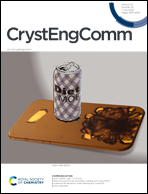1-(2-Methoxyphenyl)-3-phenyl-1,4-dihydro-1,2,4-benzotriazin-4-yl: a tricky “structure-to-magnetism” correlation aided by DFT calculations†
Abstract
1-(2-Methoxyphenyl)-3-phenyl-1,4-dihydro-1,2,4-benzotriazin-4-yl (2) is a Blatter radical with a challenging structure-to-magnetism correlation. The nearly orthogonal 2-methoxyphenyl group disrupts the ability of the radical to form columns of π-stacked molecules typically observed in organic radicals with extended π-conjugated aromatic frameworks. The experimental magnetic susceptibility data are best interpreted in terms of an alternating antiferromagnetic Heisenberg linear chain model with A1Jexp = 2JA = −6.74 cm−1, A2Jexp = 2αJA = −2.70 cm−1. Two possible 1D chains of alternating radicals (C1 and C2) were identified. However, owing to significant differences in the packing arrangement of the molecules and the similar lengths of the shortest intermolecular contacts within the chains, a convincing structure-to-magnetism correlation was not straightforward. DFT calculations reproduced with high accuracy the experimentally determined microscopic magnetic exchange interactions and showed beyond reasonable doubt that the observed magnetic susceptibility data are attributed to chain C2. Radicals within chain C2 are near perpendicular to each other (87.76°) and form a herringbone pattern. There are two weak hydrogen interactions H3⋯N4 and H23⋯N1, both antiferromagnetic in nature and one shorter than the other (2.478 vs. 2.516 Å), that account for the experimentally determined exchange interactions (−6.74 vs. −2.70 cm−1).



 Please wait while we load your content...
Please wait while we load your content...